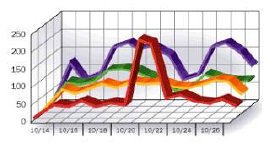Or Engipreneurs?
What happens when a professional expert turns into an Entrepreneur? When a Doctor starts her own hospital or an attorney his law firm, what are the challenges, symptoms of caution and mistakes that characterize this transformation? Do they get overwhelmed by business functions or they never loose their domain focus? This article is inspired by these questions and the most common inhabitants of Silicon Valley, the ‘Engipreneurs’.
Silicon Valley is full of Engineers and Entrepreneurs. By engineers and for the purpose of this article, I mean Software Engineers. There is a third category of inhabitants seen largely here and I like to call them as ‘Engipreneurs’. As the name suggests, these are Engineers who have turned into Entrepreneurs’.
The word "engineer" derives from the Latin word ingenium - innate character, talent, or ability. “Entrepreneur” has its roots in the French word entreprendre which means to undertake or take action. An engineer applies mathematics, science, and systems-integrative approaches to conceive, design, build, and operate useful objects or processes; whereas an entrepreneur assumes the tasks of organization and management as well as the risks of new-project creation or new-venture startup.
The definitions above bring in a key point of consideration; engineers create objects and entrepreneurs create businesses around these objects.
So what happens when the two meet – when Engineers become Entrepreneurs? By definition this seems to be the most ideal thing to happen. Now, an engineer not only creates the object of worth but also builds a business around it, brings intended users close to the object. But many a time, this is not the case. And more often than not, an over-enthusiast engineer may not bring in the best business value from his entrepreneurial venture. The reason is simple – ‘not letting go’! I have tried to analyze some of the most common syndromes, practices that characterize these ‘engipreneurs’ (who do not let go). Take a look and eliminate as many as possible in case you are preparing to become one successful entrepreneur.
‘The Best Technology Syndrome’ – If you have ever worked or lived closely with engineers you will know, that they attach a lot of importance to the best technology. Their judgment of a worthy proposition is one that ensures or demonstrates ‘The best Technology’. This syndrome keeps them continuously focused on the ‘best’ as seen from ‘their’ eyes. If you can create a wireless communication mechanism between Earth and Mars, yeah that is a ‘wow’ technology. But who will be there to take your call in Mars? This is the work of scientists, not entrepreneurs. So the key here is ‘it is not the best technology that is all important but the potential market for the technology that drives businesses. And isn’t there always something ‘better’ than the ‘best’?
‘Good vs Perfect’
I have known several engineers who are always in the attempt of making the ‘perfect’ software. I say, a ‘good’ software is much better than a perfect one, if it reaches the market on time. Entrepreneurs have to deliver what they have promised and they have to do so in time. If they loose out on time, there is someone already waiting to occupy the space. This does not mean the software product should be buggy but it should not be perfected so much as to delay the entire business cycle. And by the way, who has seen a ‘perfect’ software till now? The first version of ‘Windows’ would still be incubating, if one waited to perfect it.
‘Innovative product or innovative use’
Many engineers who turn to become entrepreneurs often think that they have to come up with an innovative product. This is not untrue. An innovative product always attracts attention not just of users but also of venture capitalists. Having said this, how many innovative software products have we seen in last few years? If you try to analyze the trend, what will glaringly become clear is that it is not innovative product but innovative use that makes a big difference. So, engineers have to also look into the side box marked as ‘innovative uses’. It makes them no less engineers if they have used somebody else’s technology. Businesses would have stopped creating web-based emails, once HotMail got popularity or they would not have invested millions in search technology, if they thought that Google has done it all. These and numerous other examples suggest that not only thinking innovative product, but also thinking innovative use, makes it big in business.
‘The Right Time’
This is a very overly stated and underly estimated phrase. The cliché ‘there is always’ a right time’ is always right. There is no need for your product if you are not fast enough to meet the demand or fulfill the generated demand of your product. You can create a wow effect, but unless you are delivering to that ‘wow’, it soon will frizzle out. So however good your product is, always bear in mind, it has to be presented at the right time. Sometimes, this right time is to fasten and launch your product, sometimes it entails waiting to launch it later. Why do you think, Microsoft is not launching its long promised and awaited ‘Vista’? Think about it.
‘Risk-taking is not gambling’
Yes! When entrepreneurs take risks, they take it in measured way. They calculate and base their risk on certain parameters. But they are known to take risks. Engineers however are not trained to take risks. By definition, they base their judgments on proven and predictable methods and formulae. There is no such formula for success. However, you plan and predict the market variables it is your gut that dictates majority of your decisions. Well after all, ‘the riskiest thing to do in business is NOT to take any risks’.
‘Painting hands red, green and blue’
There are other languages in the world than ‘Programming’! I am yet to see an Engineer who thinks of a problem as faced by users. In most cases, the discussion around a problem is so concentrated to the underlying programming language, database and other software artifacts that the actual essence of the problem is lost. This and the fact that an engineer will very seldom leave his focus away from the code that runs the software, doesn’t let an engineer think beyond the software point of view. What is an added advantage to an entrepreneur becomes an obsession and soon turns out to be an obstacle. This I call painting hands red, green and blue because, engineers cannot keep their hands away from code.
‘Network vs Network’
One of the characteristic that amuses me of Engineers is the way they sneer at the mention of group party or group activity. They talk a lot, but only if the discussion is around some ‘cool’ technology. To them rest all meetings, discussions are mundane. Networking to them is when two or more computers talk to each other. Networking to entrepreneurs is ‘socializing’. This is an important transition from ‘machine’ to ‘human’ interface that engineers have to acknowledge in order to become successful entrepreneurs.
‘Passion vs Ego’
Lastly, I would like to close this list of characteristics with a very important distinction, pointed out by my husband, couple of days back. When we say, we are passionate about something; we are actually more egoistic than passionate. Passion soon becomes an ego issue, when it is pursued to prove a point. When an engineer turns into an entrepreneur, very subtly the passion becomes his ego. Now, more than making a good business proposition, he becomes obsessive to prove a point. Not all entrepreneur ventures are meant to be highly acceptable and very successful. To follow your passion means to give in your best but also accepting failure and success with equal weights. Like one of my friends always says “You don’t succeed unless you fail”.
To summarize it all, entrepreneurial or engineering characteristics are very much a matter of mindset. When you are an engineer and want to become an entrepreneur, it is like accepting the fact that you will be sharing the house with your two wives. How happy you want yourself to be depends on how you keep a balance between the two wives. My advice “do not love one over the other”.




